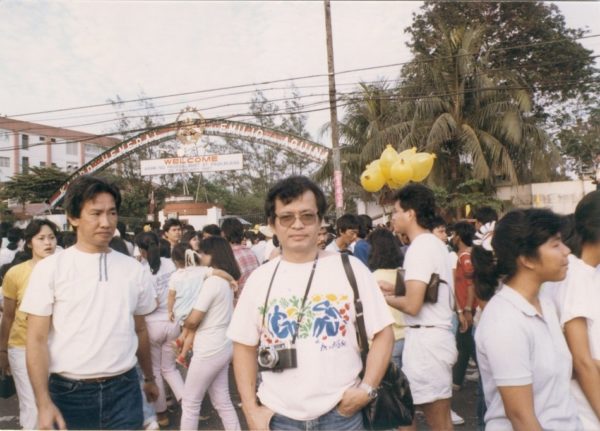On my 79th birthjday. Manny Maramara and Mark Wiley joined me for dinner (courtesy of Mark) at Daddy’s Place (Mommy’s Kitchen), a Moroccan restaurant in downtown Easton. I often say it was my 80th because as a person with Chinese ancestry I also consider the 9 months in the womb as a year. A friend also told me that the Chinese skip 79th and go on to the next year to celebrate. But I am not one to miss a birthday. So there we were with a feast in front of us — grilled chicken, beef and lamb with a skewer of onions, peppers and tomatoes, hummus, babaganoush, salad, pita bread, kibbe, tabouli and a few other dishes I do not have the names for. We had Turkish coffee and tiramisu for dessert. I was even able to blow the candle. I was like a kid in a toy store. Sorry, no beer. We were all teetotaler. Hallelujah!






Back in the 1990s I used to practice Classical Yang Family Tai chi chuan fist and sword forms at the parking lot of Walden Pond, whatever the season. Afterwards, I would follow the path to the spot where Henry David Thoreau built his shack. It was a ritual pilgrimage I would take every time I was there. There was a time when Debra Kang Dean and I would practice together at the Walden Farm and read poetry at the Borders Books in Framingham. One fact that is not well known about Thoreau: he had a copy of the Bhagavad Gita with him. This was long before the chakras and yoga became popular in the West. I wonder what he thought about Chapters 10 and 11 when Krishna demonstrated his divine person in earthly terms and as the Supreme Being. Thoreau is one of the most quotable writers in the history of American literature. Aside from “Simplify, Simplify,” “Marching to a different drummer” and “Always we have to contend with the stupidity of man,” here are a couple:
“You must live in the present, launch yourself on every wave, find your eternity in each moment. Fools stand on their island of opportunities and look toward another land. There is no other land; there is no other life but this.”
“I find it wholesome to be alone the greater part of the time. To be in company, even with the best, is soon wearisome and dissipating. I love to be alone. I never found the companion that was so companionable as solitude.”
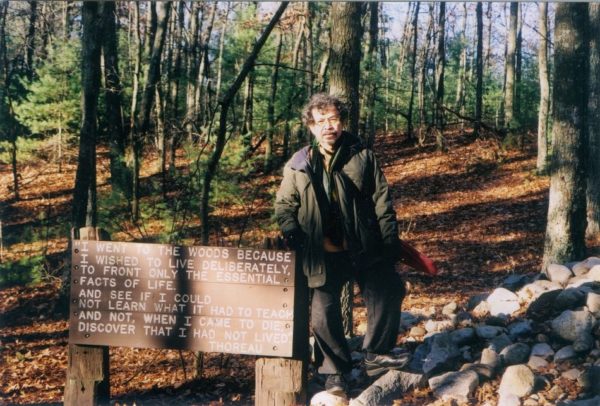
Jenny Romero Llaguno (widow of my friend Frankie) invited me to join her at a gathering at Cafe Havana (Greenbelt 3) in Makati on my last full day last December in the Philippines. She introduced me to the “Wednesday Group” — so-called. because they meet on Wednesday. It was originally organized by Carmen Guerrero Nakpil. I do not recall the others but I do remember Rony Diaz (short story writer), Gemma Cruz, Lirio Calixto), and last but not least Esperanza Ramirez (author of “Heart’s Flower,” biography and poetry of Shenkei, a Japanese Buddhist monk. New to the group, I just listened to the conversations at the long table, but I had a short but memorable conversation with Esperanza (nickname: Espie). She has a doctorate in Japanese literature. We talked about the haiku, Makoto Ueda’s book “Basho and his Interpreters,” Roland Barthes’ “Empire of Signs,” (3 chapters are devoted to the haiku), and the Japanese Buddhist concept of muslin/emptiness (Wuxin in Chinese). Sadly, we did not have more time to talk. She is one of the most interesting people I have met, no kidding. I have been studying the Lord Buddha’s sermon to Shariputra, the Heart Sutra, and listening to its reading on a CD and it made our brief conversation more interesting. I got a copy of Esperanza’s book when it first came out in 1994. All the strange coincidences in my life. I hope I’ll see more of her in the future. I am sure I’ll learn a lot from her.
My friends Jimmy Yambao and Agustin Que were also in the gathering but they were in the back. Jenny gave me a copy of her book of short stories, “A Woman with Money.” She is sitting across from me.
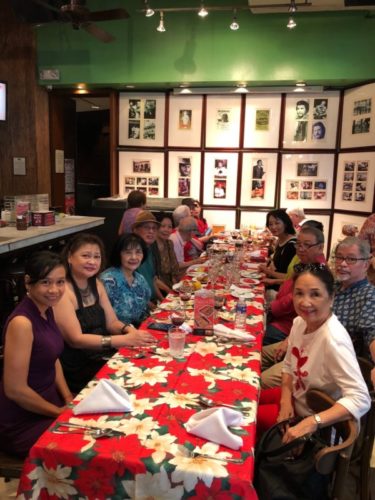
I first met Len Roberts when he facilitated a poetry workshop at Lafayette College in Easton, PA back in 1985. After I read a couple of my poems, he asked me to see him at his office. “Bring some of your poems,” he said. Apparently he liked the poem Sulu, about the bombing of a Muslim city in Southern Philippines. He was the resident poet of the school at the time and I was the manager of a legal services program in Newton, NJ. A few days later, I brought a bunch of poems for him to critique. He zeroed in on one poem, “The Old Calligrapher,” about a Buddhist monk who was meditating in a stone garden when the atomic bomb exploded on Hiroshima. Since then, Len and I spent time together. We read together in NJ and in Pennsylvania. One time I visited him at his house where we had dinner and sat in front of the fireplace reading poetry and listening to Yoyo Ma. I gave a tribute at his funeral service at Northampton Community College where he taught. You can read a piece about him in the Writings section of the website.
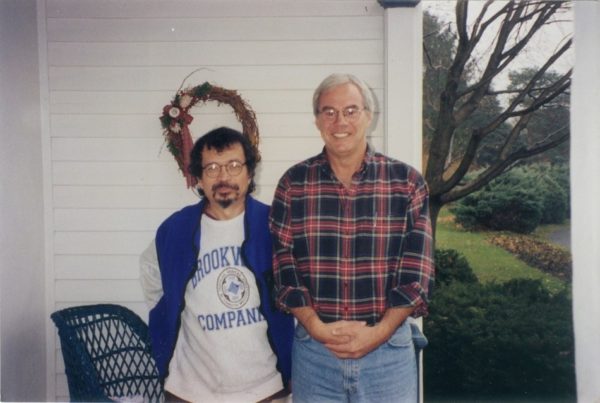
Laura Billingham Navarro and Isabel ready to rake the Autumn leaves from the property in Creek Road, Frenchtown. I do not know how old Isabel was — 2 or 3? Well, they have to make an early start because there’s 18 acres to do.
How time passes. Isabel has just celebrated her 22md birthday and is now pursuing a doctorate program in biro-medical engineering at Penn. She’s a Fellow of the National Science Foundation.
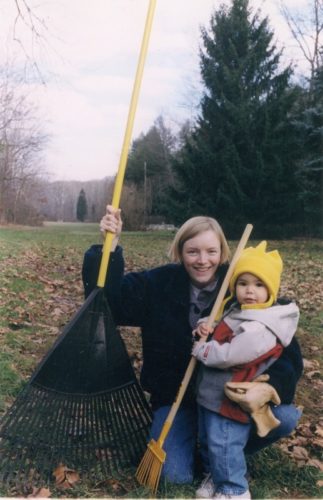
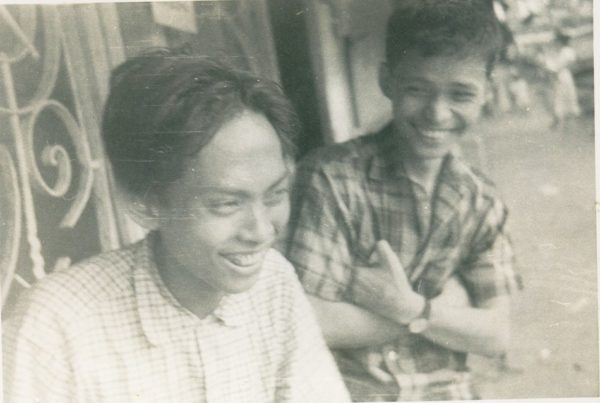
David Cortez Medalla outside of his shack (called Le Cave de Angely) in Ermita, Manila. Back in the mid-50s, he introduced Manila to poetry reading. It was from him that I first heard of Eugenio Montale’s Dora Marcus, Juan Ramon Jimenez’ Criatura Afortunada and TS Eliot’s The Wasteland. I was a 16-year old freshman in college finding his way around the city’s cultural life. With a great curiosity, I explored the bookstores and libraries. During those early years I read Kerouac’s “On the Road” and “Dharma Bums,” “Selected Poems and New” of Jose Garcia Villa and “The Last Temptation of Christ” by Nikos Kazantzakis. When he left the Philippines in the 1960s for London , where he became a resident, he engaged in art and has been featured in different exhibits in art installation around the world.
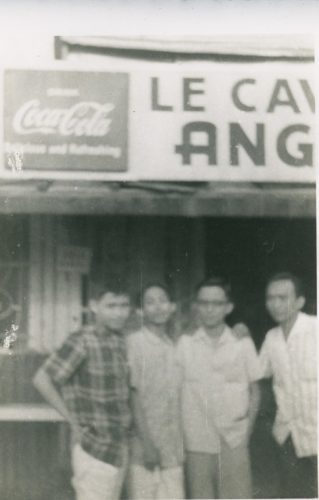
Here is what l remember of David’s “Psalm” from 1957 :
The Lord is my Gardener.
He shall come to me
A parasite-ridden parched tree
Standing in a desert of poisonous ponds
Bulls’ bones and granite jewels
Of phosphorescent stones.
He shall come to me
And pluck the worms
From my waterless, strengthless roots.
He shall bring me forth his showers
To drown my thirst
And soothe my sores
Until once more
I burst into songs
And poems
And flowers.
Xuan Kong, grandmaster of the lineage that practices Yi Jin Jing and related disciplines, is a healer and magus. I had the privilege of meeting him in Huangshan, Anhui province, China in October 2007 through the intercession of David Verdesi. I also met Jiang Feng, another phenomenal healer and David’s immediate teacher. That’s me behind the monk in the first photo. Kneeling beside GM Xuan is his disciple Jiang Feng. The second photo shows the Grandmaster as he descended the Cave of the Immortals. A breatharian, he lived in caves most of his life. The third photo shows him through a hole in a paper that he burned with his Qi from a distance. I haven’t seen anybody like him in my 79 decades of searching. Sadly, he and Jiang passed away the last few years. Read about them in my essay “Thunder Path in Huangshan” in the Writings section of the website.
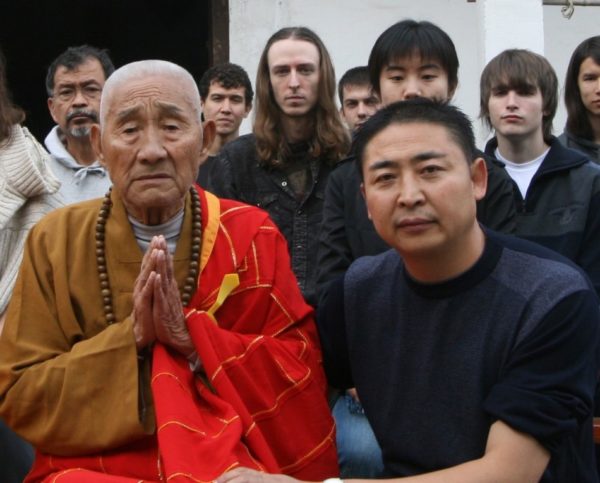
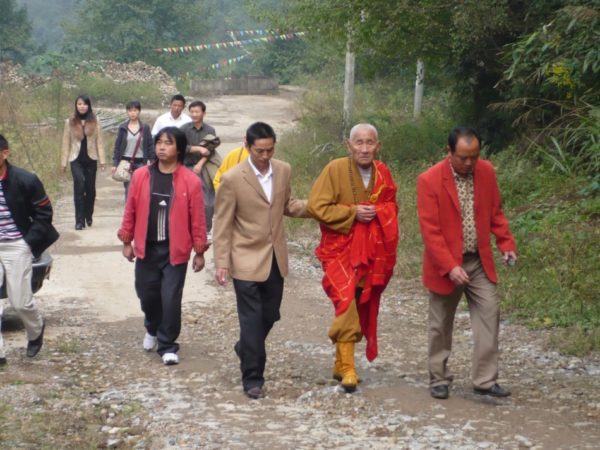
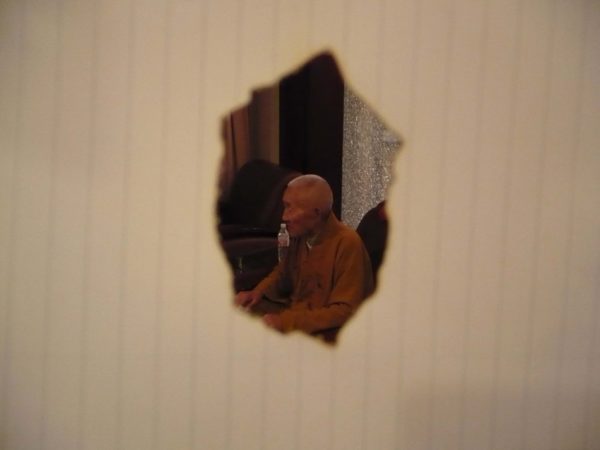
Prague gallery
(Click to view larger image.)







Message from Vic Ramos, friend from college and former Philippine Environmental Secretary:
“Photo of the tree that you planted in our farm. Kupang or drumstick tree, scientific name Parkia timoriana. Its bark is med for scabies, boils or abscesses. Young leaves are edible.”


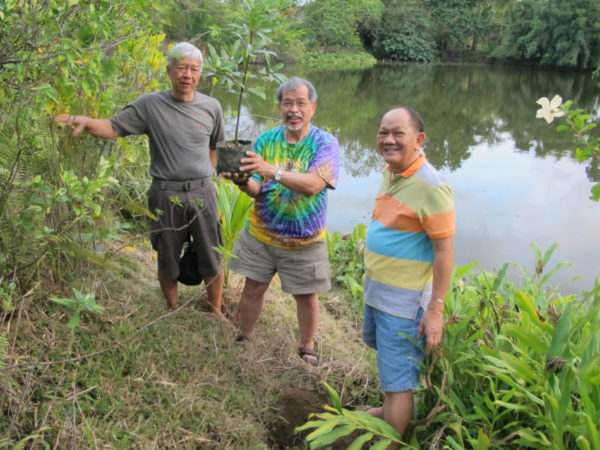
I planted the tree at Vic’s farm in Pangasinan a few years ago. Vic has at least 120 endemic snd indigenous trees and plants in the farm.
Annette Derksen was the sponsor of my seminars in Amsterdam in 2000. The cold wind from the North Sea was blowing in. I did not have any warm clothes at the time, so I had to go shopping in the Red Light district. The coat I got did not provide enough insulation for the cold weather. I taught a few basic courses but also The Lesser Enlightenment of Kan and Li, a neidan or alchemical Transmission that GM Mantak Chia learned from Yi Yun, One Cloud Hermit in Hong Kong, and a Shaolin Hong Kuen fist form called “Fairy Child Praying to the Goddess of Mercy Guanyin” that I studied with GM Lao Kim and GM Johnny Chiuten. Annette was also born in 1940, a Metal Dragon, like me.
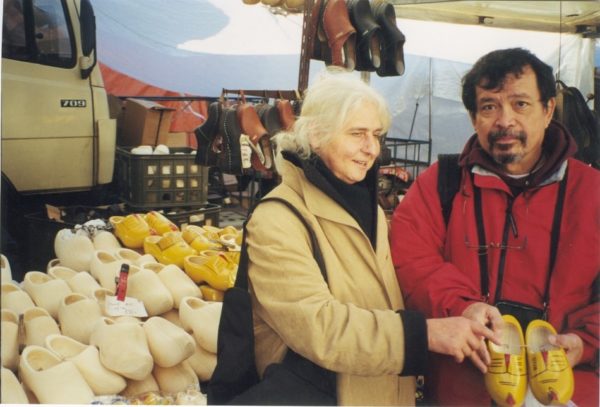
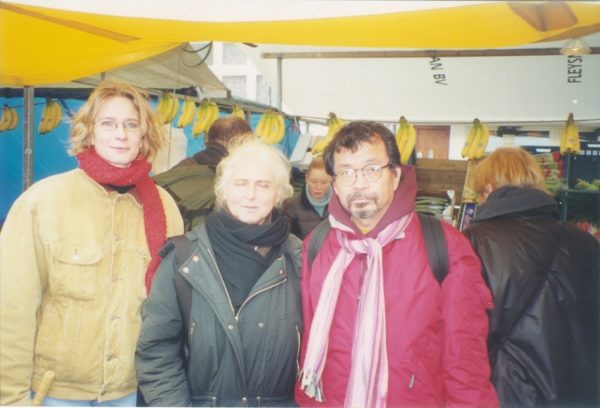
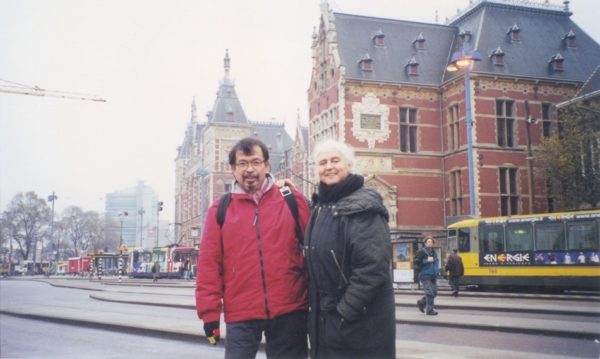
Photos taken at the Celebration of Nelson Navarro’s Life. Held at the Kalayaan Hall of the Philippine Consulate on October 4, 2019, it was sponsored by the Alpha Phi Beta Fraternity.For my tribute to Nelson, please read “Nelson A. Navarro: In Memoriam” in the Writings section of the website.
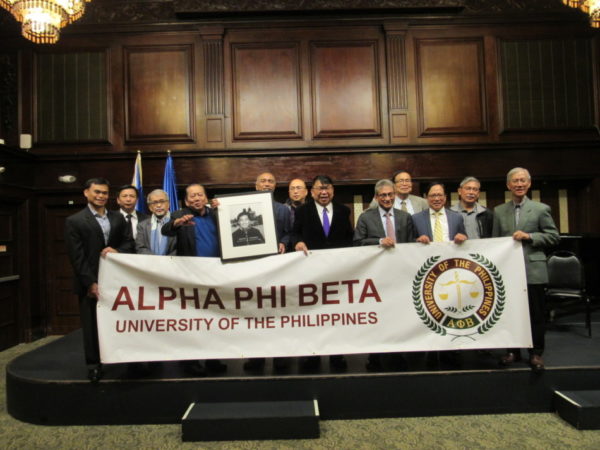
L-R: Christian V. Bautista, Rommel Manuel, Rene Navarro , Manny Chan, Thor Lidasan, Franz Mascariñaz, Dante Raul Teodoro, Salvador Tuy, Emil de Guzman, Alenn Nidea, Renato Enojado, Carlos Esguerra .
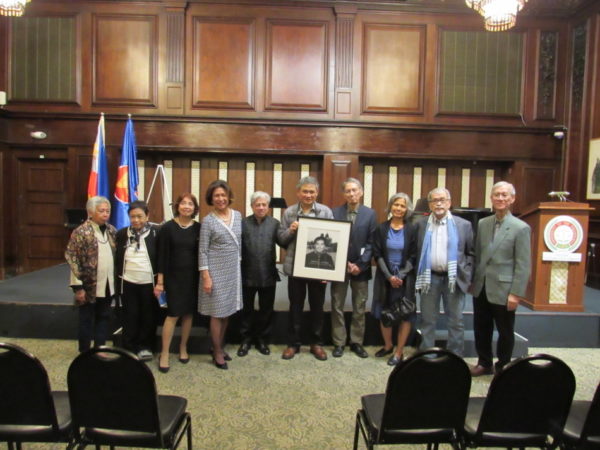
L-R: Marie Luarca-Reyes, Lilia Calderon-Clemente, Elvie Tengco, Loida Nicolas-Lewis, Michael Dadap, Revelino Pascual, Rene Navarro and Carlos Esguerra.
I visited the Carlos P. Romulo Memorial Library and Museum in Tarlac City, my hometown, on November 30. I was invited by the Chief Librarian Edna Quiballo. When I was in high school, there was a library in town but it did not have the books I wanted to read. I am donating most of my collection to the library. Shown with me are to my left Edna Quiballo, Dr Cookie Villamil and Annie Sollestre.
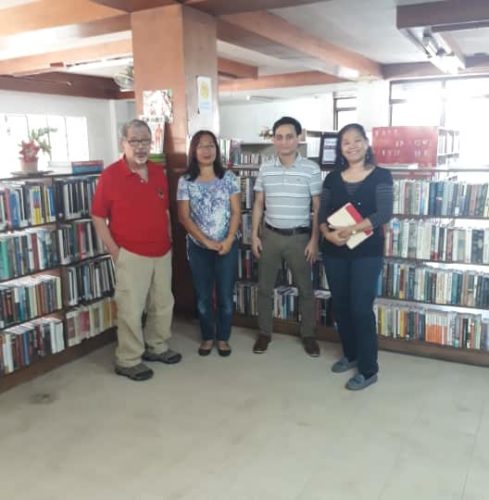
Dr. Alejandro Roces, former secretary of education and anti-Marcos stalwart, and I were walking down EDSA (Epifanio de los Santos Avenue), the center of the People Power Revolution. A photojournalist snapped the photo and gave a copy to Dr. Roces. I knew Mang Anding — his nickname — from our work with PETAL (Philippine Educational Theatre Arts League) at LaMama ETC in NYC in the early 1980s. He gave lectures on Philippine culture. I taught arnis de mano/Philippine stick fighting and appeared in the PETAL productions.
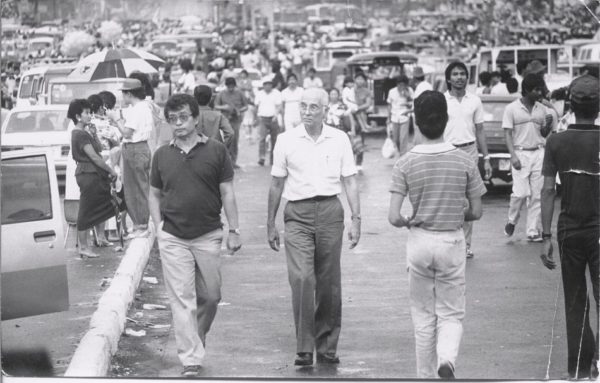
That’s me at EDSA outside a military camp during the celebrations of the February revolution in 1986.
